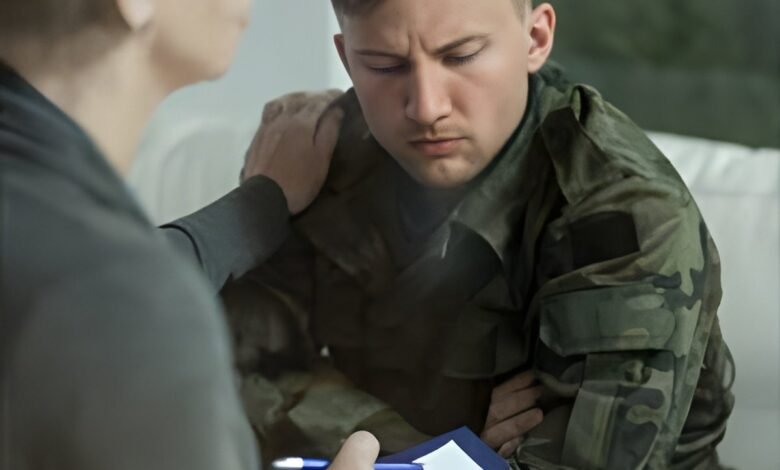Transformative Combination Therapy for PTSD Veterans

Effectiveness of combining two treatments is as unveiled as a promising and enduring solution for addressing post-traumatic stress disorder (PTSD), particularly in military veterans, offering hope for improved quality of life, as per a clinical trial conducted among U.S. military veterans at the Providence Veterans Affairs Medical Center (1✔ ✔Trusted Source
Virtual Reality and Transcranial Direct Current Stimulation for Posttraumatic Stress Disorder A Randomized Clinical Trial
).
The participants who received brain stimulation with a low electrical current during sessions of virtual reality exposure reported a significant reduction in PTSD symptom severity. The results were reported in JAMA Psychiatry.
New Avenues in PTSD Treatment
“This is a different and innovative way of approaching treatment where we’re combining the best aspects of psychotherapy, neuroscience, and brain stimulation to help people get better,” said Philip, who leads mental health research at the Providence V.A. Center for Neurorestoration and Neurotechnology.
#posttraumaticstressdisorder #ptsd #militaryveterans
’
“There’s a lot of promise here, and that offers hope.”
PTSD is a common psychiatric disorder characterized by intrusive thoughts and recollections, avoidance of trauma-related stimuli, hyperarousal, and disturbed mood, the study noted. Initial PTSD treatments often include trauma-focused exposure therapy and medication.
Yet PTSD is particularly difficult to treat in military veterans, Philip said. Medications have significant adverse effects, and exposure therapy can be difficult to tolerate since it involves describing highly traumatic experiences repeatedly.
Up to 50% of patients drop out of traditional exposure therapy, and others decline to even start it.
For the study, Philip, whose background is in psychiatric research of brain simulation, teamed up with Mascha van ‘t Wout-Frank, an associate professor of psychiatry and human behavior (research) at the Warren Alpert Medical School who studies the effect of non-invasive brain stimulation on “fear extinction,” or learning that things that are regarded as harmful can actually be safe and can therefore become tolerable.
Advertisement
Did You Know?
VR experiences can be customized to provide immersive environments for patients undergoing rehabilitation or coping with chronic pain.
“Through exposure therapy, the brain is reprocessing the trauma, and learning that even though the traumatic experience was dangerous, the memories of the traumatic experience, as well as the thoughts and feelings that are conjured up by those memories, are not dangerous — they are safe,” said van ‘t Wout-Frank, an investigator at the V.A. Providence Center for Neurorestoration and Neurotechnology.
Advertisement
“This results in a decline in conditioned fear response.”
A leading theory of PTSD posits that the effectiveness of exposure as therapy is impaired due to ineffective top-down control of the brain’s amygdala by the ventromedial prefrontal cortex and other brain regions.
Affected individuals thus have impaired safety learning and memory, which in healthy people is supported by intact brain function, van ‘t Wout-Frank said.
The Promise of Healing
Transcranial direct current stimulation, which involves administering a constant, low, pain-free electrical current to a part of the brain, is well-suited to potentially augment trauma-focused exposure therapy, van ’t Wout-Frank said.
The non-invasive current may boost neural activity, facilitating top-down control by the ventromedial prefrontal cortex to improve safety learning.
The research team decided to combine transcranial direct current stimulation with virtual reality exposure, which provides a highly immersive sensory experience including visual, tactile, and even olfactory stimuli to simulate real-world environments.
To test the combined treatment, the researchers expanded a previous pilot study to conduct a larger, more robust, double-blind study of 54 U.S. military veterans with chronic PTSD.
Participants were randomly assigned to receive transcranial direct current stimulation or a sham experience that provided some sensation but not a significant amount or duration of electrical current.
In the patients receiving transcranial direct current stimulation, a low (2 milliamp) amount of electricity was targeted to the ventromedial prefrontal cortex during six 25-minute sessions of standardized warzone virtual reality exposure, delivered over two to three weeks.
Participants in the active transcranial direct current stimulation group reported a superior reduction in self-reported PTSD symptom severity at one month.
While all participants had meaningful reductions in PTSD symptoms (attributed to the VR procedure), active transcranial direct current stimulation significantly accelerated psychological and physiological adjustment to the virtual reality events between sessions compared with the sham treatment patients.
In the experiment, the virtual reality was generalized to include trauma-inducing elements but didn’t replicate any one participant’s personal experience.
“It can be difficult for patients to talk about their trauma over and over, and that’s one common reason that participants drop out of psychotherapy,” Philip said. “This VR exposure tends to be much easier for people to handle.”
In just two weeks, the combination of electric stimulation plus VR treatment accelerated a process that happens normally during prolonged exposure therapy but usually takes around 12 weeks to show effects.
What’s more, Philip added, the effects continued to build over time.
“What we found was that people continued to get better after they were done with the treatment, and we started seeing the biggest effects one month later,” Philip said.
The team is continuing to review the study results to better understand how the treatment caused brain changes over time. Future studies would explore a larger group of study participants, a longer follow-up time, and perhaps even the effects of re-treatment.
Reference:
- Virtual Reality and Transcranial Direct Current Stimulation for Posttraumatic Stress Disorder A Randomized Clinical Trial
– (https://jamanetwork.com/journals/jamapsychiatry/fullarticle/2815835)
Source-Eurekalert
Source link
#Transformative #Combination #Therapy #PTSD #Veterans



